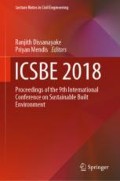Abstract
Since the 1950s, reactors using algal-bacterial polycultures have been engineered by researchers to treat wastewater. The symbiotic relationship between algae and bacteria accommodates energy-efficient wastewater treatment by eliminating artificial aeration. Here, we investigated the applicability of a novel algal-based system using two polycultures to treat primary-settled municipal wastewater under field conditions in a winter climate (average daily temperature: 4–16.5 °C). The two polycultures were cultured in two closed 700L bioreactors deployed at a local wastewater treatment plant in Las Cruces, NM, United States. The Ammoniacal nitrogen and phosphate concentrations and OD750 of the two reactors were analyzed daily. The BOD5 in the reactors were analyzed once in two days. The samples from the two reactors were analyzed over 44 days from January to March in 2018. The culture in reactor 1 attained average ammoniacal nitrogen, phosphate, and BOD5 removals of 99.3%, 70.1%, and 70.0% respectively in a single step within five days. The corresponding efficiencies for reactor 2 were 44.3%, 47.5%, and 50.7%. The average batch processing times for reactor 1 and reactor 2 were 1.02 and 4.02 days respectively. This paper confirms the ability of both the polycultures to treat primary-settled wastewater in a single step.
Access this chapter
Tax calculation will be finalised at checkout
Purchases are for personal use only
References
de Godos I, Blanco S, García-Encina PA, Becares E, Muñoz R (2009) Long-term operation of high rate algal ponds for the bioremediation of piggery wastewaters at high loading rates. Bioresour Technol 100:4332–4339. https://doi.org/10.1016/J.BIORTECH.2009.04.016
Oswald WJ, Gotaas HB, Golueke CG, Kellen WR, Gloyna EF, Hermann ER (1957) Algae in waste treatment [with discussion]. Sewage Ind Wastes 29:437–457. http://www.jstor.org/stable/25033322
Muñoz R, Guieysse B (2006) Algal–bacterial processes for the treatment of hazardous contaminants: a review. Water Res 40:2799–2815. https://doi.org/10.1016/J.WATRES.2006.06.011
García J, Mujeriego R, Hernández-Mariné M (2000) High rate algal pond operating strategies for urban wastewater nitrogen removal. J Appl Phycol 12:331–339. https://doi.org/10.1023/A:1008146421368
Bordel S, Guieysse B, Muñoz R (2009) Mechanistic model for the reclamation of industrial wastewaters using algal–bacterial photobioreactors. Environ Sci Technol 43:3200–3207. https://doi.org/10.1021/es802156e
Su Y, Mennerich A, Urban B (2011) Municipal wastewater treatment and biomass accumulation with a wastewater-born and settleable algal-bacterial culture. Water Res 45:3351–3358. https://doi.org/10.1016/J.WATRES.2011.03.046
Selvaratnam T, Henkanatte-Gedera SM, Muppaneni T, Nirmalakhandan N, Deng S, Lammers PJ (2016) Maximizing recovery of energy and nutrients from urban wastewaters. Energy 104:16–23. https://doi.org/10.1016/j.energy.2016.03.102
Henkanatte-Gedera SM, Selvaratnam T, Karbakhshravari M, Myint M, Nirmalakhandan N, Van Voorhies W, Lammers PJ (2017) Removal of dissolved organic carbon and nutrients from urban wastewaters by Galdieria sulphuraria: laboratory to field scale demonstration. Algal Res 24:450–456. https://doi.org/10.1016/J.ALGAL.2016.08.001
Mehrabadi A, Craggs R, Farid MM (2015) Wastewater treatment high rate algal ponds (WWT HRAP) for low-cost biofuel production. Bioresour Technol 184:202–214. https://doi.org/10.1016/J.BIORTECH.2014.11.004
Park JBK, Craggs RJ, Shilton AN (2013) Enhancing biomass energy yield from pilot-scale high rate algal ponds with recycling. Water Res 47:4422–4432. https://doi.org/10.1016/J.WATRES.2013.04.001
Tchinda D, Henkanatte-Gedera SM, Abeysiriwardana-Arachchige ISA, Delanka-Pedige HMK, Munasinghe-Arachchige SP, Zhang Y, Nirmalakhandan N (2019) Single-step treatment of primary effluent by Galdieria sulphuraria: removal of biochemical oxygen demand, nutrients, and pathogens. Algal Res 42:101578. https://doi.org/10.1016/J.ALGAL.2019.101578
Martínez M, Sánchez S, Jiménez F, El Yousfi L, Muñoz L (2000) Nitrogen and Phosphorus removal from urban wastewater by the microalga Scenedesmus obliquus. Bioresour Technol 73:263–272. https://doi.org/10.1016/S0960-8524(99)00121-2
Axelsson L (1988) Changes in pH as a measure of photosynthesis by marine macroalgae. Mar Biol 294:287–294. https://doi.org/10.1007/BF00391314
Droop M (1975) The nutrient status of algal cells in batch culture. J Mar Biol Assoc UK 55(3):541–555. https://doi.org/10.1017/S0025315400017240
Chevalier P, Proulx D, Lessard P, Vincent WF, de la Noüe J (2000) Nitrogen and phosphorus removal by high latitude mat-forming cyanobacteria for potential use in tertiary wastewater treatment. J Appl Phycol 12:105–112. https://doi.org/10.1023/A:1008168128654
Henkanatte-Gedara S (2018) Urban wastewater treatment by Galdieria sulphuraria: single step process for dissolved organics and nutrient removal. New Mexico State University
Author information
Authors and Affiliations
Corresponding author
Editor information
Editors and Affiliations
Rights and permissions
Copyright information
© 2020 Springer Nature Singapore Pte Ltd.
About this paper
Cite this paper
Abeysiriwardana-Arachchige, I.S.A., Chapman, W., Nirmalakhandan, N. (2020). Algal Wastewater Treatment: Study of Polyculture in Fed-Batch Mode in a Winter Climate. In: Dissanayake, R., Mendis, P. (eds) ICSBE 2018. ICSBE 2018. Lecture Notes in Civil Engineering , vol 44. Springer, Singapore. https://doi.org/10.1007/978-981-13-9749-3_10
Download citation
DOI: https://doi.org/10.1007/978-981-13-9749-3_10
Published:
Publisher Name: Springer, Singapore
Print ISBN: 978-981-13-9748-6
Online ISBN: 978-981-13-9749-3
eBook Packages: EngineeringEngineering (R0)

